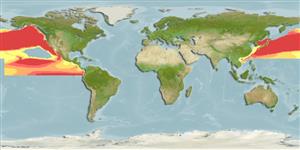>
Ophidiiformes (Cusk eels) >
Ophidiidae (Cusk-eels) > Neobythitinae
Etymology: Bassozetus: Latin, bassus = thick, fat + Greek, ketos = marine mosnter, whale (Ref. 45335).
Eponymy: Lev Aleksandrovich Zenkevich (1889–1970) was a Russian oceanographer and zoologist. [...] (Ref. 128868), visit book page.
Environment: milieu / climate zone / Tiefenbereich / distribution range
Ökologie
seewasser bathypelagisch; tiefenbereich 0 - 6930 m (Ref. 58302). Deep-water
North Pacific.
Size / Gewicht / Alter
Geschlechtsreife: Lm ? range ? - ? cm
Max length : 26.3 cm SL Männchen/unbestimmt; (Ref. 31384)
Snout inflated; eyes much smaller than snout; opercular spine weak or absent; preopercle without spines and posteriorly expanded almost reaching posterior margin of opercle; pseudobranchial filaments 2 (Ref. 34024).
Rare, deep pelagic species (Ref. 34024). Benthopelagic (Ref. 58302). Oviparous, with oval pelagic eggs floating in a gelatinous mass (Ref. 205). Of the 5 female specimens caught, 2 with 0.5 mm eggs. No identifiable stomach contents were found. Specimen collection used non-closing, pelagic fishing gear (bottom trawls) (Ref. 84269). Minimum depth from Ref. 58018.
Life cycle and mating behavior
Geschlechtsreife | Fortpflanzung | Ablaichen | Eier | Fecundity | Larven
Machida, Y. and Y. Tachibana, 1986. A new record of Bassozetus zenkevitchi (Ophidiidae, Ophidiiformes) from Japan. Jap. J. Ichthyol. 32(4):437-439. (Ref. 31384)
IUCN Rote Liste Status (Ref. 130435: Version 2025-1)
Bedrohung für Menschen
Harmless
Nutzung durch Menschen
Fischereien: nicht kommerziell
Tools
Zusatzinformationen
Download XML
Internet Quellen
Estimates based on models
Preferred temperature (Ref.
123201): 0.2 - 3.3, mean 1.9 °C (based on 856 cells).
Phylogenetic diversity index (Ref.
82804): PD
50 = 0.5000 [Uniqueness, from 0.5 = low to 2.0 = high].
Bayesian length-weight: a=0.01000 (0.00244 - 0.04107), b=3.04 (2.81 - 3.27), in cm total length, based on all LWR estimates for this body shape (Ref.
93245).
Trophic level (Ref.
69278): 3.6 ±0.6 se; based on size and trophs of closest relatives
Widerstandsfähigkeit (Ref.
120179): hoch, Verdopplung der Population dauert weniger als 15 Monate. (Preliminary K or Fecundity.).
Fishing Vulnerability (Ref.
59153): Low vulnerability (22 of 100).
🛈
